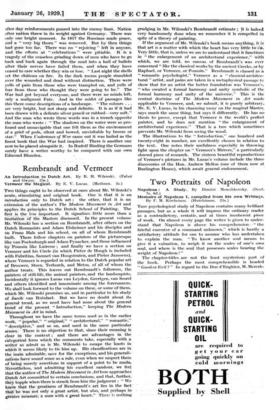Rembrandt and Vermeer
An Introduction to Dutch Art. By R. H. Wilenski. (Faber and Gwyer. 25s.) Vermeer the Magical. By E. V. Lucas. (Methuen. 5s.)
Twci things ought to be observed at once about Mr. Wilenski's acute, stimulating and original book. One is that it is an introduction only to Dutch art ; the other, that it is an extension of the author's The Modern Movement in Art and applies its principles to the Dutch School of Painting. The first is the leis important. It signalizes little more than a limitation of the Masters discussed. In the present volume Mr. Wilenski has a section on Rembrandt, after others on the Dutch Romanists and Adam Elsheimer and his disciples and on Frans Hals and his school, on all of whom Rembrandt built. There follow chapters on painters of the picturesque like van Poelenburgh and Adam Pynacker, and those influenced by 'Pinissin like Lairesse ; and finally we have a section on Vermeer and his Circle (in which Pieter de Hoogh is included with Fabritius, Samuel van Hoogstraten, and Pieter Janssens), where Vermeer is regarded in relation to the Dutch popular art of Brouwer, Steen, Terborch, and Metsu, of all of whom the author treats. This leaves out Rembrandt's followers, the painters of still-life, the animal painters, and the landscapists. Incidentally it ignores Lucas van Leyden, Geertgen, van Scorel and others identified and innominate among the forerunners. We shall look forward to the volume on these, or some of them. which -Mr. Wilenski promises us, and in particular to his study of jamb' van Ridsdael. But we hive no doubt about its general trend, as we need have had none about the general trend of the present " Introduction," keeping The Modern Movement in Art in mind.
Throughout we have the same terms used as -in the earlier Work, .."popular," "- original;" " architectural," " romantic," " descriptive," and so on, and used in the same particular senses: ' There is no objection to that, since their meaning is clear in the context ; and there are advantages in the categorical form which the comments take, especially with a writer' so adroit as is Mr. Wilenski to escape the -knots in which it seems likely to tie him up. His classifications are in the main admirable, save for the exceptions, and his generali- zations have sound. sense as a rule, even when we suspect them of being merely assertions iri support of a point to be made. NeVertheless, -and admitting - his excellent candour, we feel that the'author of The Modern Mcivement in Art here approaches Dutch Art committed tb certain conclusions, and that, further, they topple when there is struck from him the judgment : " We kno* that the 'greatness of Rembrandt's' art lies in the fact - that he was not only a great artist, but also; and perhaps in greater measure," a man with a great heart." Them is nothing
grudging in Mr. Wilenski's Rembrandt estimate ; it is indeed very handsomely done when we remember it is compelled in spite of a theory of painting.
If the argument of Mr. Wilenski's book means anything, it is that art is a matter with which the heart has very little to dr. Very little, that is, unless we are to understand that it functions in " the enlargement of an architectural experience," with which, we are told, no canvas of Rembrandt's was ever concerned " like the classical works by the ancient Greeks, or by Raphael, or Vermeer, or Poussin." Rembrandt is classed as a " romantic psychologist," Vermeer as a " classical-architee- tural " artist, and pains are taken in a metaphysical passage to show that for an artist the better foundation was Vermeer's, " who created a formal harmony and unity symbolic of the formal harmony and unity of the universe." This is the central doctrine of The Modern Movement in Art made applicable to Vermeer, and, we submit, it is purely arbitrary. Mr. E. V. Lucas, in his charming essay on the magital Master, says much the same thing, but says it differently. He has no thesis to prove, except that Vermeer is the world's perfect painter, and he does not mention " the enlargement of architectural experience." That is a tree which sometimes prevents Mr. Wilenski from seeing the wood.
The illustrations to the " Introduction," one hundred and twenty-eight in number, are excellently chosen in relation to the text. One notes their usefulness especially in throwing light upon the chapter on " Vermeer's Mirrors," a particularly shrewd piece of research. The sixteen beautiful reproductions of Vermeer's pictures in Mr. Lucas's volume include the three discoveries of the Hon. Andrew Mellon (one of them now at Burlington House), which await general endorsement.








































 Previous page
Previous page